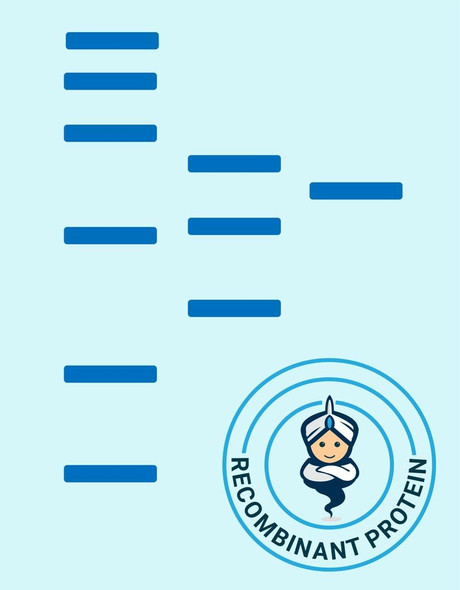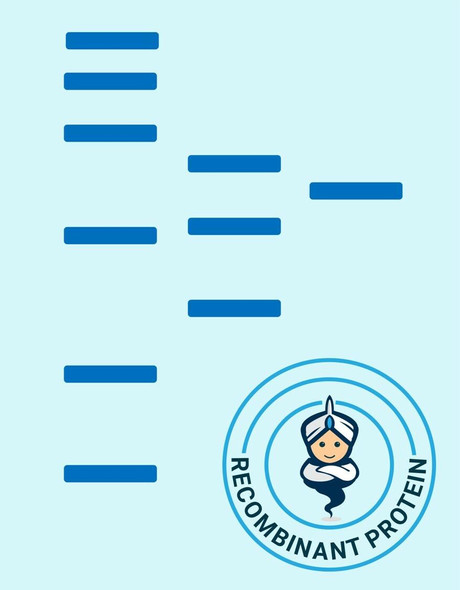Human EFNB3 Recombinant Protein (RPPB3415)
- SKU:
- RPPB3415
- Product Type:
- Recombinant Protein
- Species:
- Human
- Uniprot:
- Q15768
Description
| Product Name: | Human EFNB3 Recombinant Protein |
| Product Code: | RPPB3415 |
| Size: | 20µg |
| Species: | Human |
| Target: | EFNB3 |
| Synonyms: | Ephrin-B3, EPH-related receptor transmembrane ligand ELK-L3, EPH-related receptor tyrosine kinase ligand 8, LERK-8, EFNB3, EPLG8, LERK8, EFL6. |
| Source: | Escherichia Coli |
| Physical Appearance: | Sterile Filtered colorless solution. |
| Formulation: | EFNB3 protein solution (1mg/ml) containing 20mM Tris-HCl buffer (pH8.0), 20% glycerol, 0.1M NaCl and 2M urea. |
| Stability: | Store at 4°C if entire vial will be used within 2-4 weeks. Store, frozen at -20°C for longer periods of time. For long term storage it is recommended to add a carrier protein (0.1% HSA or BSA).Avoid multiple freeze-thaw cycles. |
| Purity: | Greater than 90% as determined by SDS-PAGE. |
| Amino Acid Sequence: | MGSSHHHHHH SSGLVPRGSH MGSHMLSLEP VYWNSANKRF QAEGGYVLYP QIGDRLDLLC PRARPPGPHS SPNYEFYKLY LVGGAQGRRC EAPPAPNLLL TCDRPDLDLR FTIKFQEYSP NLWGHEFRSH HDYYIIATSD GTREGLESLQ GGVCLTRGMK VLLRVGQSPR GGAVPRKPVS EMPMERDRGA AHSLEPGKEN LPGDPTSNAT SRGAEGPLPP PSMP |
Ephrin-B3 (EFNB3) which belongs to the ephrin gene family is essential in brain development as well as in its maintenance. EFNB3 binds to, and induces the collapse of, commissural axons/growth cones in vitro. EFNB3 loosely binds Eph receptors located on bordering cells, leading to contact-dependent bidirectional signaling into neighboring cells. The EPH and EPH-related receptors comprise the largest subfamily of receptor protein-tyrosine kinases and are implicated in mediating developmental events, mostly in the nervous system.
EFNB3 Human Recombinant produced in E.Coli is a single, non-glycosylated polypeptide chain containing 224 amino acids (28-226 a.a) and having a molecular mass of 24.6kDa.EFNB3 is fused to a 25 amino acid His-tag at N-terminus & purified by proprietary chromatographic techniques.
| UniProt Protein Function: | EFNB3: Cell surface transmembrane ligand for Eph receptors, a family of receptor tyrosine kinases which are crucial for migration, repulsion and adhesion during neuronal, vascular and epithelial development. Binds promiscuously Eph receptors residing on adjacent cells, leading to contact-dependent bidirectional signaling into neighboring cells. The signaling pathway downstream of the receptor is referred to as forward signaling while the signaling pathway downstream of the ephrin ligand is referred to as reverse signaling. May play a pivotal role in forebrain function. Binds to, and induce the collapse of, commissural axons/growth cones in vitro. May play a role in constraining the orientation of longitudinally projecting axons. Belongs to the ephrin family. |
| UniProt Protein Details: | Protein type:Ligand, receptor tyrosine kinase; Cell development/differentiation; Membrane protein, integral Chromosomal Location of Human Ortholog: 17p13.1 Cellular Component: integral to plasma membrane; plasma membrane Molecular Function:transmembrane-ephrin receptor activity; ephrin receptor binding Biological Process: axon guidance; nervous system development; viral reproduction; cell-cell signaling; axon choice point recognition; ephrin receptor signaling pathway; adult walking behavior |
| NCBI Summary: | EFNB3, a member of the ephrin gene family, is important in brain development as well as in its maintenance. Moreover, since levels of EFNB3 expression were particularly high in several forebrain subregions compared to other brain subregions, it may play a pivotal role in forebrain function. The EPH and EPH-related receptors comprise the largest subfamily of receptor protein-tyrosine kinases and have been implicated in mediating developmental events, particularly in the nervous system. EPH Receptors typically have a single kinase domain and an extracellular region containing a Cys-rich domain and 2 fibronectin type III repeats. The ephrin ligands and receptors have been named by the Eph Nomenclature Committee (1997). Based on their structures and sequence relationships, ephrins are divided into the ephrin-A (EFNA) class, which are anchored to the membrane by a glycosylphosphatidylinositol linkage, and the ephrin-B (EFNB) class, which are transmembrane proteins. The Eph family of receptors are similarly divided into 2 groups based on the similarity of their extracellular domain sequences and their affinities for binding ephrin-A and ephrin-B ligands. [provided by RefSeq, Jul 2008] |
| UniProt Code: | Q15768 |
| NCBI GenInfo Identifier: | 2494367 |
| NCBI Gene ID: | 1949 |
| NCBI Accession: | Q15768.1 |
| UniProt Secondary Accession: | Q15768,O00680, Q8TBH7, Q92875, B2RBW2, D3DTQ6, |
| UniProt Related Accession: | Q15768 |
| Molecular Weight: | 340 |
| NCBI Full Name: | Ephrin-B3 |
| NCBI Synonym Full Names: | ephrin-B3 |
| NCBI Official Symbol: | EFNB3�� |
| NCBI Official Synonym Symbols: | EFL6; EPLG8; LERK8�� |
| NCBI Protein Information: | ephrin-B3; Ephrin B3; eph-related receptor tyrosine kinase ligand 8; EPH-related receptor transmembrane ligand ELK-L3 |
| UniProt Protein Name: | Ephrin-B3 |
| UniProt Synonym Protein Names: | EPH-related receptor transmembrane ligand ELK-L3; EPH-related receptor tyrosine kinase ligand 8; LERK-8 |
| Protein Family: | Ephrin |
| UniProt Gene Name: | EFNB3�� |
| UniProt Entry Name: | EFNB3_HUMAN |










